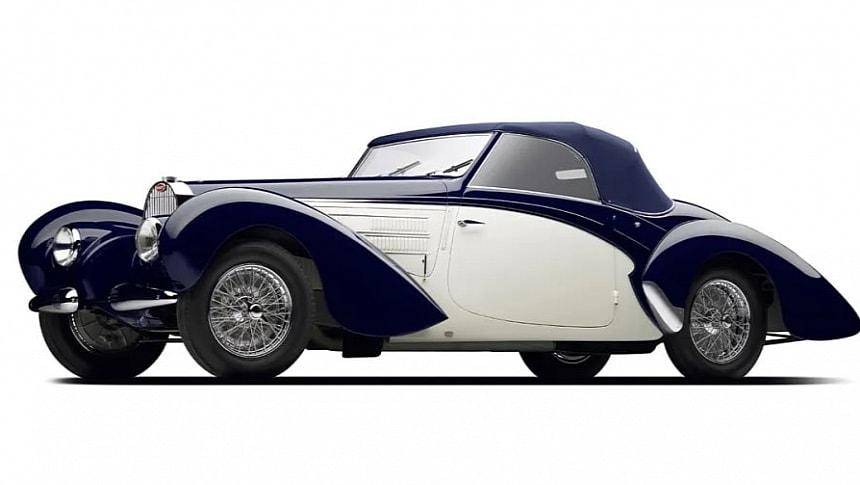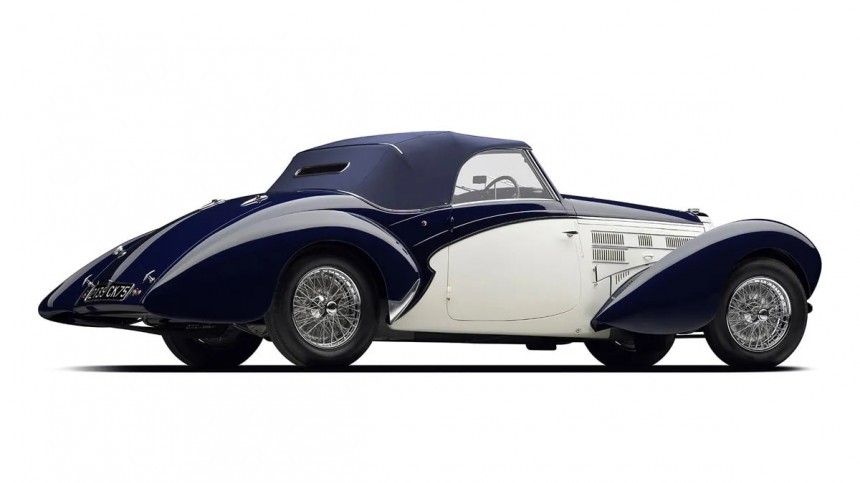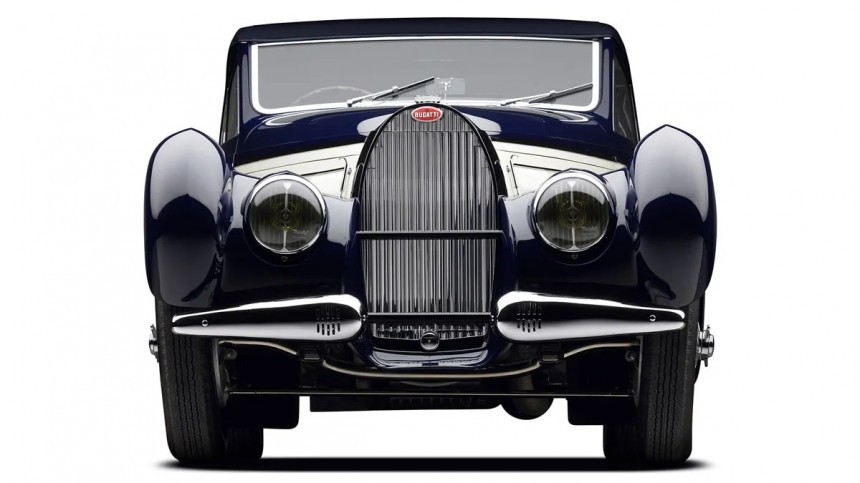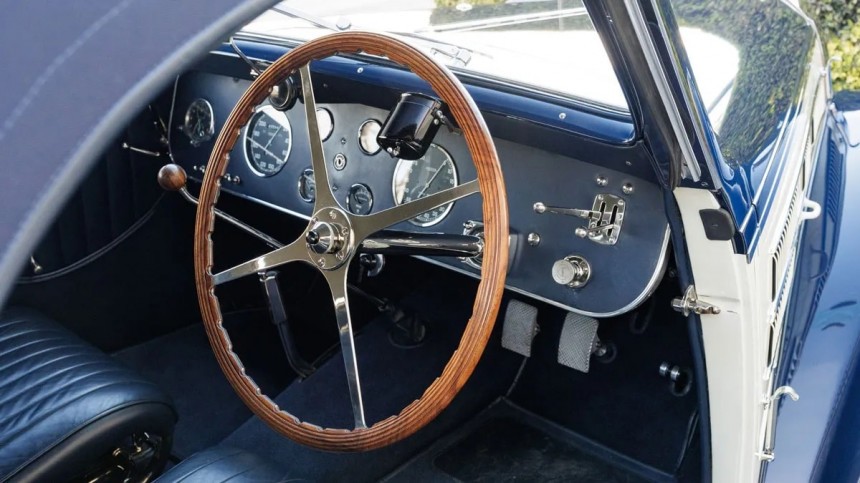The Art Deco movement, which was prominent in the 1930s and 40s, is arguably one of the most recognizable design trends of the last century and influenced not only architecture, interiors, jewelry, and household objects but also automobiles. The artistic approach to car design resulted in the creation of models characterized by unrelenting elegance and beauty, and the few surviving examples are now seen as sheer works of art.
Today, most of these cars are preserved in museums and collectors' garages, and the rest of us, mortal petrolheads, are left drooling upon these rolling pieces of fine art. The Mullin Automotive Museum in Oxnard, California, which officially closed its doors in February after the passing of Peter Mullin, is home to one of the most extensive collections of Art Deco vehicles. One of them is this Bugatti Type 57C Aravis "Special Cabriolet," a car that was specifically built for Maurice Trintignant, Bugatti's famous team driver who raced it at the Grand Prix du Comminges in 1939.
Introduced as an entirely new design created by Jean Bugatti, son of founder Ettore, in 1934, the Bugatti Type 57 was regarded as an engineering marvel that delivered excellence on all fronts, including power, performance, and style. It was the first new model built under Jean Bugatti’s direction and came fitted with a 3.3-liter twin-cam, straight-eight engine producing 135 hp. With its long hood, exquisite curves, and handcrafted details, the car oozed elegance and speed and represented the pinnacle of automotive design at that time.
Bugatti produced the grand tourer model between 1934 and 1940 and continually refined it throughout its production run. The Type 57C, with the “C” standing for compresseur, was a supercharged version powered by the same 3.3-liter engine from the road-going Type 57, but delivered 160 hp with a Roots-type blower. The model also boasted magneto ignition, four-wheel hydraulic brakes, and various other upgrades that made it one of the finest high-performance vehicles of the pre-WWII era, capable of a top speed well in excess of 100 mph (160 kph). It was built from 1937, with a total of only 96 units produced.
Bugatti offered the Type 57 as a bare chassis or clothed with one of the five factory-derived body styles, including Ventoux, Galibier, Stelvio, Atalante, and Aravis.
Named after a mountain pass in the French Alps, the Aravis, a two-seat “Special Cabriolet,” is one of the most striking of these designs. It is also incredibly exclusive, as only 11 were ever made by coachbuilders Gangloff, Letourneur et Marchand, and Albert D’Ieteren. The first two fabricated five each, while the latter only one.
Only three Gangloff-bodied Aravis examples are extant today, and the breathtakingly beautiful unit you see here is one of them. This is chassis 57768, and Jean Bugatti himself called it “the most beautiful Type 57.”
Bugatti completed the rolling chassis of this unit in November 1938. It had been ordered new by Avignon agent Granat & Fils for Maurice Trintignant, a French Grand Prix racer on the Bugatti factory team. Though the car was intended as a high-performance road car, Trintignant entered it in the Grand Prix du Comminges in 1939 and finished 11th overall.
The car was originally finished in ivory with dark blue fenders, and one of its most striking features was the curvaceous body that granted enhanced aerodynamics and made it look like a work of art. It boasted a silhouette built for speed with sleek lines, sharp edges that cut through the air efficiently, and dipping teardrop-shaped fenders that flow toward the ground.
Trintignant kept the Bugatti until 1947, when it sold it to Jacques Roblin. After that, the car exchanged hands a few more times, with Madeleine Mitton and Rudi van Daalen Wetters being its next owners.
Peter Mullin acquired the ultra-rare Type 57C Aravis from Wetters’s family in 2002 and decided to give it a comprehensive restoration to return it to its former glory. Sargent Metal Works in Vermont, a renowned antique car restoration shop with a passion for pre-war Bugatti vehicles, carried out the work. The car also benefitted from a complete engine rebuild overseen by Leydon Restorations of Pennsylvania.
Interestingly, Mullin even had the opportunity to collaborate with Trintignant to ensure the authenticity of the restoration. It took three years to restore every aspect of the car to the highest standards. Attesting to the quality of the restoration, this Aravis won the First in Class award at the Pebble Beach Concours d’Élégance in 2005.
The historically significant Bugatti Type 57C Aravis "Special Cabriolet" is set to roll across the auction block on April 26 as part of Gooding & Company’s Selections from the Mullin Collection Auction, which will take place at the Mullin Automotive Museum in California. The car is offered with no reserve and is expected to fetch a staggering $3.5 million. With a well-known history, few owners since new, and an award-winning restoration, this Aravis is truly a special car - one of the greatest prewar automobiles.
Introduced as an entirely new design created by Jean Bugatti, son of founder Ettore, in 1934, the Bugatti Type 57 was regarded as an engineering marvel that delivered excellence on all fronts, including power, performance, and style. It was the first new model built under Jean Bugatti’s direction and came fitted with a 3.3-liter twin-cam, straight-eight engine producing 135 hp. With its long hood, exquisite curves, and handcrafted details, the car oozed elegance and speed and represented the pinnacle of automotive design at that time.
Bugatti offered the Type 57 as a bare chassis or clothed with one of the five factory-derived body styles, including Ventoux, Galibier, Stelvio, Atalante, and Aravis.
Named after a mountain pass in the French Alps, the Aravis, a two-seat “Special Cabriolet,” is one of the most striking of these designs. It is also incredibly exclusive, as only 11 were ever made by coachbuilders Gangloff, Letourneur et Marchand, and Albert D’Ieteren. The first two fabricated five each, while the latter only one.
Only three Gangloff-bodied Aravis examples are extant today, and the breathtakingly beautiful unit you see here is one of them. This is chassis 57768, and Jean Bugatti himself called it “the most beautiful Type 57.”
The car was originally finished in ivory with dark blue fenders, and one of its most striking features was the curvaceous body that granted enhanced aerodynamics and made it look like a work of art. It boasted a silhouette built for speed with sleek lines, sharp edges that cut through the air efficiently, and dipping teardrop-shaped fenders that flow toward the ground.
Trintignant kept the Bugatti until 1947, when it sold it to Jacques Roblin. After that, the car exchanged hands a few more times, with Madeleine Mitton and Rudi van Daalen Wetters being its next owners.
Interestingly, Mullin even had the opportunity to collaborate with Trintignant to ensure the authenticity of the restoration. It took three years to restore every aspect of the car to the highest standards. Attesting to the quality of the restoration, this Aravis won the First in Class award at the Pebble Beach Concours d’Élégance in 2005.
The historically significant Bugatti Type 57C Aravis "Special Cabriolet" is set to roll across the auction block on April 26 as part of Gooding & Company’s Selections from the Mullin Collection Auction, which will take place at the Mullin Automotive Museum in California. The car is offered with no reserve and is expected to fetch a staggering $3.5 million. With a well-known history, few owners since new, and an award-winning restoration, this Aravis is truly a special car - one of the greatest prewar automobiles.















